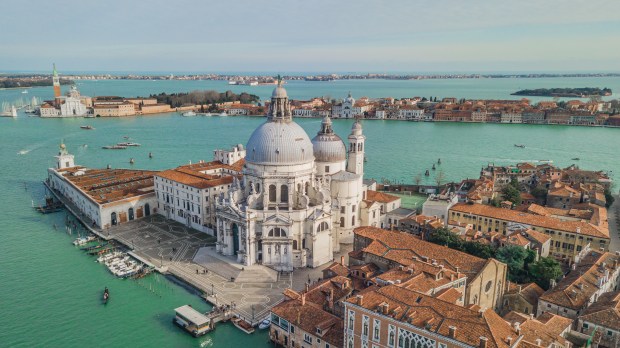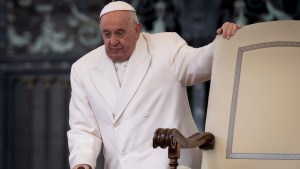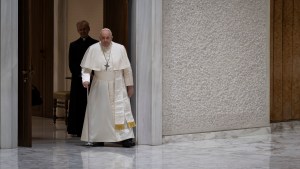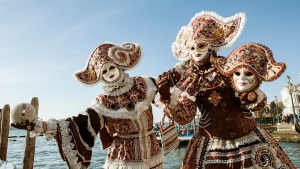Pope Francis will be in Venice on April 28, 2024, for his first trip of the year. By visiting the Holy See’s pavilion, housed in a women’s prison, he will become the first pontiff to visit the famous Art Biennale of Venice.
In this article we look back at the main issues at stake in this brief papal visit to the lagoon.
The Pontiff has not made a trip since his visit to France last September. With Venice, he is inaugurating something of a tour of northeastern Italy, since he is due to visit Verona in May and Trieste in July.
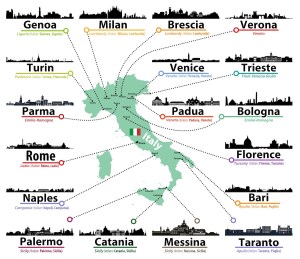
Health concerns
This trip also comes shortly after the announcement of a major 12-day international trip to Southeast Asia and Oceania, scheduled for September. The latter has reopened the question of the Pontiff’s ability to continue traveling, and Venice should provide an initial answer to this question.
In addition to his mobility difficulties, which have now become a constant, the Pope has also experienced health problems in recent months, forcing him to cancel at the last minute a trip to the United Arab Emirates in December 2023, and his participation in certain events in Rome, notably this year’s Via Crucis.
However, Cardinals Christophe Pierre and François Bustillo, who were in Rome last weekend to take possession of their parishes as cardinals, met the Pontiff and assured I.MEDIA that he was in good shape.
This is Francis’ 37th trip to Italy. He has visited most of Italy’s major cities. He has made six visits to Assisi, the city of the saint he chose as his namesake.
In the footsteps of five previous popes
Pope Francis is the fourth pope to visit Venice since the Second World War. Paul VI made the trip in 1972, during which he presented his papal stole to the patriarch of the time, Archbishop Albino Luciani, who would later succeed him as John Paul I.
John Paul II visited the lagoon in 1985, as did Benedict XVI, who even stayed overnight in May 2011.
In Venice, the Pontiff will also walk in the footsteps of two former patriarchs: John Paul I, whom he beatified in 2022, and John XXIII, canonized at the same time as John Paul II ten years ago on April 27, 2014. Another pope dear to the Argentine pontiff’s heart headed the Venetian patriarchate between 1893 and 1903: St. Pius X.
An intense day
The Pontiff will cover the 250 miles (400 km) from Rome to Venice by helicopter, with an estimated flight time of an hour and a half. The Pontiff’s white AgustaWestland is due to land in the central square of the women’s prison on the island of Giudecca, south of the historic center, at around 8:30 am.
The Pope will be welcomed by the prison police commander, the head of Veneto prisons and Archbishop Francesco Moraglia, patriarch of Venice since 2012. He will meet prisoners and staff in the prison yard.
After a speech, he will proceed to the Church of the Magdalene, a 16th-century chapel inside the center. There, at around 9 am, he will have a conversation with the nine artists the Holy See is exhibiting in its national pavilion at the Venice Biennale, and deliver a second speech.
The Holy See’s pavilion
The Holy See’s pavilion at the Biennale is organizing an exhibition titled “With My Eyes,” curated by Cardinal José Tolentino de Mendonça, Prefect of the Dicastery for Culture and Education. The pavilion, which involved female prisoners in its design, aims to offer visitors a different perspective, moving away from a form of voyeurism all too present in contemporary society and encouraging a way of looking that, on the contrary, touches reality.
One of the main works is found on the façade of the prison. It’s a monumental photograph of the two feet of a reclining person, reminiscent of Andrea Mantegna’s famous “Christ.” It’s the work of Italian artist Maurizio Cattelan, famous for his controversial works, including The Ninth Hour, a statue he made in 1999 of John Paul II being crushed by a meteorite.
Mass in St. Mark’s Square
The Pontiff will then leave the island of Giudecca by speedboat for La Salute (Our Lady of Salvation), the famous white marble basilica built in the 17th century to thank the Virgin Mary for protecting Venice from a plague. There, he will meet a delegation of young people from the region and deliver a third speech.
Pope Francis will then leave the Basilica and cross a “bridge of gondolas,” comparable to the votive bridges built for the great religious festivals of the Serenissima. In the presence of the mayor and prefect of the city and the president of the Veneto region, he will cross the Grand Canal on foot to reach St. Mark’s Square.
There, the Pontiff will celebrate Sunday Mass in the presence of the city’s Catholic community, and deliver the homily and the Easter Marian prayer, the Regina Caeli. He will then gather in St. Mark’s Basilica before the relics of the Evangelist, the patron saint of the city, whose feast day on April 25 will have preceded his visit by only a few days.
The only change to the program is that the Pope will be leaving from his point of arrival, contrary to what had been announced by the Holy See at the outset. He will return to the Giudecca women’s prison for take-off at 1 pm, landing at the Vatican heliport at 2:30 pm.
